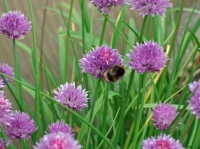
Create your own culinary herb garden that looks almost too good to eat!
Try planting a selection of tasty herbs valued as much for their ornamental appeal as their flavour. From sage to thyme, rosemary to clipped bay and flowering chives, combine herbs valued for their ornamental beauty to produce long-lasting displays as well as regular pickings for the kitchen.
There are no hard and fast rules about creating herb gardens, but successful designs often define the space using brick pavers, dividing-up the area with small paths to provide easy access for picking. Go for an informal mix or choose a formal pattern or cartwheel design. As a centrepiece plant a large, shrubby herb such as rosemary or sage, a formally clipped bay tree, or a potted herb arrangement.
In small spaces herbs can be grown in pots, either planting them individually and grouping pots together into displays or creating bold combinations in larger containers. As many herbs have Mediterranean origins they relish a site in full sun where they can bake during summer. Soil must be free-draining too, as wet and waterlogged ground will lead to root damage, and for pots choose a free-draining loam-based compost.
Low-growing thyme is a herb garden favourite, perfect for making a herb carpet, softening the edges of gravel paths, or filling gaps between paving. With flavoursome foliage in greens, silvers and golds, plus colourful flowers too, they’ll look good and provide pickings all year.
Whether adding to salads, cooking with new potatoes, or making herb teas, mint is a versatile herb with many uses. Their colours and flavours vary immensely from powerful peppermint and spearmint to those with an underlying taste of apple, citrus, banana, red berries, and many more. And for chocoholics everywhere there’s even Chocolate Peppermint with a hint of dark chocolate. Irresistible!
Just remember that mint is one herb that’s always best kept contained to prevent it invading your borders, so grow it in a pot or large bottomless bucket.
Rosemary is a hardy shrub with aromatic leaves and long flowering season. ‘Miss Jessopp’s Upright’ is a popular variety with statuesque habit, but for large patio pots also consider a variety from the Prostratus Group with a weeping habit that will gracefully arch over the sides of the container.
Try flavouring casseroles, soups and sauces with homemade bouquet garni made from sprigs of thyme and parsley wrapped in a bay leaf. Alternatively other herbs can be added to suit your culinary creations, such as rosemary, basil, chervil or tarragon. Herbs have so many uses from using fresh in cooking, making pesto, infusing into herb oils and vinegars, or making herb teas.
A wonderful assortment of herb plants are available at garden centres now, so buy your favourites to create your own culinary herb gardens. Many herbs can be raised from seed too, so buy packets of coriander, basil, parsley, chives and many others.
HERB TOPIARIES
Several shrubby herbs can be clipped and trained into formal topiary features. These living sculptures not only look striking but their clippings can be used in cooking or dried and stored.
The best herb topiaries are created using upright growing varieties of rosemary, sweet bay, sage, lemon verbena, Greek myrtle, or even tender perennials like scented leaf pelargoniums.
Popular shapes for training bay include balls, cones, pyramids, spirals and standards (with a clipped head on a short woody leg). Skilled commercial growers even create bay trees with striking twisted corkscrew stems.
TOP TIPS FOR SUCCESFUL HERB GARDENS
- Although many herbs are of Mediterranean origin and relish hot dry conditions, to get the best from herbs in pots most require regular watering to prevent their compost drying out completely. Try standing pots in saucers of water so pots can take up moisture as required.
- Add fertiliser to one watering a week to keep plants growing strongly, or mix slow-release fertiliser granules into compost at planting time.
- Regular picking some herbs, like basil, encourages side shoots to form, keeping plants bushy and productive.
- Pick and dry the leaves of herbs like thyme, sage, bay and many others to store and use when cooking.
- The flowers of many herbs can be used to brighten summer salads. Use flowers from chives, basil, coriander and thyme, and flowers or petals from daylilies, pot marigolds, nasturtium, lavender and others. NB Always check flowers are edible before eating.
- Coriander has a habit of bolting or running to seed, but enjoy their flowers as they’ll encourage beneficial insects, like hoverflies, into your garden. Let plants set seed, then collect and dry coriander seeds to grind and use when cooking spicy Indian dishes.
FOUR HARDY HERBS FOR POTS OR BORDERS
Rosemary (Rosmarinus officinalis)
Mint varieties
Chives – both regular onion flavoured and Garlic Chives.
Thyme (Thymus varieties)
Include AGM winners like golden thyme (Thymus ‘Aureus’), ‘Silver Queen’, ‘Pink Chintz’, lemon scented ‘Bertram Anderson’.
HERB GARDEN COMPANIONS
Dozens of interesting culinary, medicinal and ornamental varieties of herbs are available to plant together and create vibrant herb gardens. Many are hardy shrubs or perennial varieties that will grow back again year after year, while others (like coriander and basil) are annual herbs that will not survive winter outside, so new plants will be needed each year.
- Angelica
- Basil
- Bergamot (Monarda)
- Borage
- Chamomile
- Chervil
- Chives
- Coriander
- Curry Plant
- Dill
- Fennel
- Garlic chives
- Greek Myrtle
- Hyssop
- Lavender
- Lemon Balm
- Lemon Verbena
- Lovage
- Marjoram (Oregano)
- Parsley – curled and flat-leaf types
- Sage (Salvia officinalis)
- Savory
- Sweet Bay (Laurus nobilis)
- Tarragon
